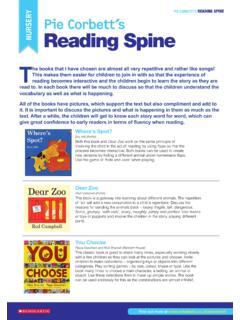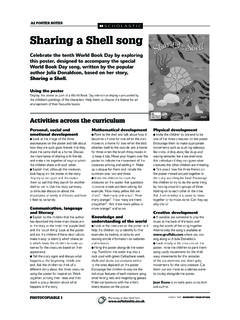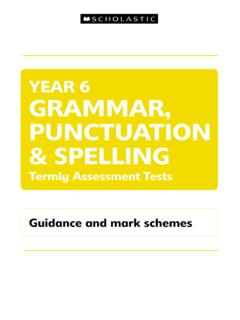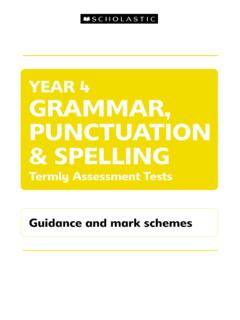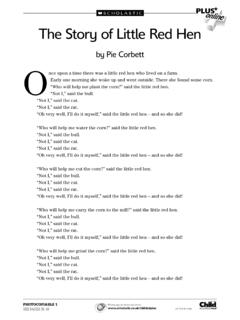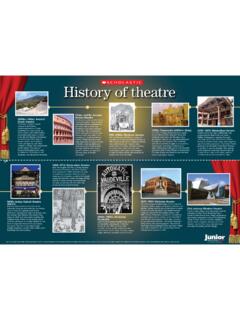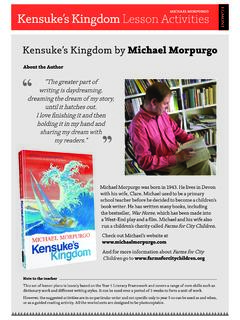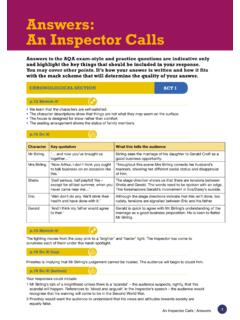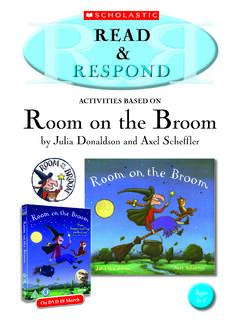Transcription of INTRODUCTION Pie Corbett’s Reading Spine
1 INTRODUCTION . PIE corbett 'S Reading Spine . Pie corbett 's Reading Spine I. magine a primary school where over 7 or 8 years, children are read to, enjoy, discuss and work with around 82 core books. These essential reads' would be a store of classics, creating a living library inside a child's mind. This is the Reading Spine '. Great Books Great books build the imagination. The more we read aloud expressively, and the more children are able to savour, discuss and reinterpret literature through the arts, the more memorable the characters, places and events become, building an inner world. A. child who is read to will have an inner kingdom of unicorns, talking spiders and a knife that cuts into other worlds.
2 The mind is like a tardis'; it may seem small but inside there are many mansions. Each great book develops the imagination and equips the reader with language. Great Stories A child who is read Great stories speak to us as individuals and some children will to will have an inner return to certain books again and again. Great stories also build our language because around 75 per cent of our vocabulary comes from kingdom of unicorns, our Reading . Reading develops the ability to think in the abstract; to talking spiders and follow lines of thought. Schools that have a Reading Spine , build a common bank of stories that bind the community together. These are a knife that cuts into shared and deeply imagined common experiences.
3 Other worlds. What is the Reading Spine ? Pie corbett The Reading Spine should be central to every school's book stock, but should also be supplemented by many other books. In the Foundation stage and Year 1, I have suggested a Spine of 12 great picture books with which children should build a strong acquaintance. Year 2 is a transition year, with both great picture books and chapter stories' included. The daily read-aloud programme is supplemented by guided, shared and independent Reading . In the Reading Spine at key stage 2, I have selected six novels in each year with a focus on one core picture book. This leaves enough space for teachers to add their own enthusiasms and new finds. Find out more at 1.
4 INTRODUCTION . PIE corbett 'S Reading Spine . Steps to a Reading Spine STEP 1. Establish the core of key books that all children will experience: these should be must have' reads the classics. The finest books that you can find! Leave space to add other books that come along or might suit the class. The aim is for every child to experience the pleasure and challenge of great literature. STEP 2. Resource the core list: class sets are very useful so that the books can then be used for close study. As well as this, sets of six books can be used for guided Reading . Also, try to gather other books/films by the same author for a wider author study. STEP 3. On a daily basis develop your ability to read aloud for pleasure with expression on a daily basis, bringing the story alive for children.
5 STEP 4. Help children to inhabit the world of the story through book discussion, drama, art, dance, music, writing-in-role and play. Imaginative engagement with the text draws children into the tale, and makes it a deeper, more memorable and meaningful experience. STEP 5. Learn how to draw on the core books to teach writing, for example, if you are teaching dialogue, use the core books as exemplars. In this way, both you and the children are constantly drawing on quality models that they will begin to know well. Moreover, the books will help to develop and deepen the children's imaginative world, as well as Establish the becoming a key resource for their writing. STEP 6 core of key books You will also need to thread in poetry .
6 The Works key stage 1 (which that all children will includes Reception) and The Works key stage 2 (both Macmillan experience: these Children's Books) provide banks of poems for enjoying, performing and discussing, and some may be used as models for writing. At the should be must have'. back of these two anthologies, the poems are organised by year group reads the classics. to create a poetry Spine . You may also wish to select core poets for each term. Finally, it is important to thread into the Reading Spine high The finest books that quality non-fiction. These books could be selected in relation to topics you can find! being studied, but there may also be key books that a school wishes to ensure children have encountered, such as The Diary of Anne Frank.
7 Find out more at 2. INTRODUCTION . PIE corbett 'S Reading Spine . Top tips for using picture books (1). O. f course, any teacher could come up character or alter a key event. with an activity linked to a book. The H Cover the dialogue with a sticky note before key is to think about activities that inviting the children to draw a speech bubble and to will illuminate the meaning, help children write, then dramatise the conversation. engage at a deeper level and enter the world of the story. Here is a whole I Pause the Reading and freeze-frame' the alphabet of activities that should spark page, then interview each character that appears your children's imagination: on it. Ask: What are you thinking/feeling/hoping will happen next?
8 What are you regretting? Alternatively, A Show the front/back cover. Ask: What sort of use thought bubbles to explore the above. story is this? What might happen? Tell the story to a partner based on the cover image or start from J Initiate a group performance using expression. the title. K Use what if' statements to raise different B Read through and pause every so often. Ask: possibilities in the narrative. What is going to happen next? Write, tell or draw the next page, then discuss. L Re-enact the story by creating a whole-class physical map, using children to represent parts of the C Invite the children to discuss what they enjoyed story. Then interview bystanders or even objects in role about the book or what it reminded them of or meant as observers of the story what did they see happen?
9 To them. D Explore links and connections. Ask: Can you find where the story repeats itself? Are there links between this story and our lives, or between this story and other stories? E As a class list possible questions, such as things we are not sure about and would like to discuss. List the questions and then choose the ones that would be most fruitful to talk about. F Role-play a scene immediately after the book has finished or before the story starts. Alternatively, select an image from the middle of the book. Ask: What is happening? What might happen immediately The key is to think about before and after? activities that will illuminate the G Ask children to draw a map of the story and retell in their own words.
10 Change the nature of a meaning, help children engage at a deeper level and enter the world of the story. Find out more at 3. INTRODUCTION . PIE corbett 'S Reading Spine . Top tips for using picture books (2). M Use percussive instruments and ask children V On the first Reading use sticky notes to cover to work in groups to set the story to simple rhythms key words in a story. Let the children discuss what and musical patterns. they think the words might be, or what the effect on the reader will be for their choice. N With the whole class create a dance to accompany a story, such as the rumpus' in Where W Rewrite a page but add extra description to the Wild Things Are (HarperCollins). compensate for withdrawing a picture.
